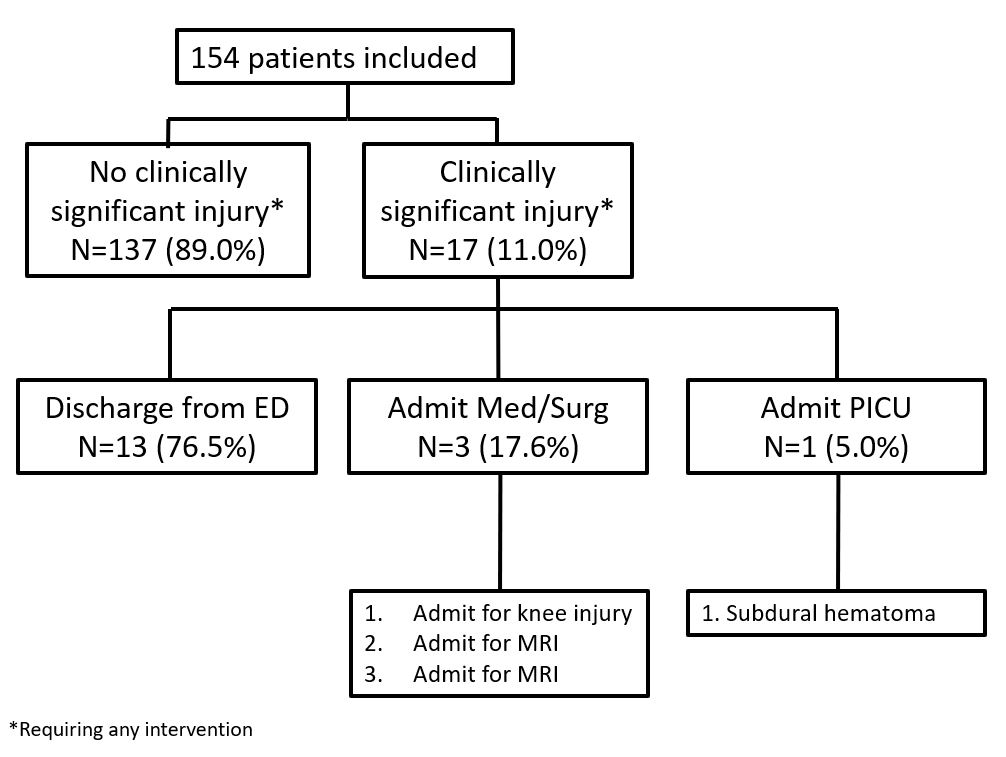Emergency Medicine: All Areas
Category: Abstract Submission
Emergency Medicine X
393 - Utility of Emergent Magnetic Resonance Imaging in Children with Persistent Traumatic Neck Pain Without Radiographic Injury
Sunday, April 24, 2022
3:30 PM - 6:00 PM US MT
Poster Number: 393
William Sokoloff, Cohen Children's Medical Center, New York, NY, United States; Vassiliki Mirisis, Cohen Children's Medical Center, Little Neck, NY, United States; Joshua Rocker, Donald and Barbara Zucker School of Medicine at Hofstra/Northwell, New Hyde Park, NY, United States

William C. Sokoloff, MD
Fellow
Cohen Children's Medical Center
New Hyde Park, New York, United States
Presenting Author(s)
Background: Pediatric patients with traumatic neck pain often require radiographic imaging to evaluate for rare, but debilitating cervical spine (C-spine) injuries. However, many alert patients without injuries seen on CT continue to have persistent neck pain and undergo emergent MRI to evaluate ligamentous or non-visualized bony injuries.
Objective: The primary purpose of this study is to describe the utility and resource burden of cervical spine MRI in the emergent setting for alert children with persistent midline neck pain, despite a normal cervical spine CT. A secondary aim is to describe the subsequent management of those injuries identified by MRI.
Design/Methods: A retrospective review was performed of children age 8-18 years-old presenting over a 6-year period to a Level 1 pediatric trauma center, who underwent both CT and MRI imaging for suspected C-spine injury. Patients with traumatic C-spine injuries on CT were excluded, as well as those with: predisposing medical conditions, those endorsing neurological symptoms, and those who were intoxicated, obtunded, disoriented, or unable to reliably participate in a physical exam. Documentation from the initial outpatient neurosurgical follow-up was also reviewed for each patient with a clinically significant injury.
Results: A total of 154 patients met inclusion criteria, of whom 89% had no clinically significant injury identified on MRI. Of those with a clinically significant injury found on MRI (n=17), none required surgical intervention and all were managed with a hard cervical collar and outpatient follow-up. No patient was admitted for management of their C-spine injury. The mean time from a normal cervical spine CT result being available to an order for admission or discharge was 542 minutes (73-1734 minutes, SD: 268 minutes) with no statistical difference between those with and without a significant injury (p=1.0). The majority of clinically significant injuries occurred secondary to motor vehicle collisions (6/17) or falls from heights (5/17) and 47.1% (8/17) of the mechanisms did not meet criteria for a trauma team activation or consult.Conclusion(s): The vast majority of children who are alert and endorse persistent traumatic C-spine tenderness despite a normal cervical spine CT, do not have a clinically significant injury identified by MRI. Those who do, appear to require minimal management with a hard cervical collar as no C-spine injury in this cohort required hospitalization or surgical intervention. ED management with a hard collar and outpatient reassessment may be a safe, resource-conscious and reasonable option for this population.
Fellow CVWilliam Sokoloff CV.pdf
Figure 1. Disposition of patients with clinically significant injuries
Objective: The primary purpose of this study is to describe the utility and resource burden of cervical spine MRI in the emergent setting for alert children with persistent midline neck pain, despite a normal cervical spine CT. A secondary aim is to describe the subsequent management of those injuries identified by MRI.
Design/Methods: A retrospective review was performed of children age 8-18 years-old presenting over a 6-year period to a Level 1 pediatric trauma center, who underwent both CT and MRI imaging for suspected C-spine injury. Patients with traumatic C-spine injuries on CT were excluded, as well as those with: predisposing medical conditions, those endorsing neurological symptoms, and those who were intoxicated, obtunded, disoriented, or unable to reliably participate in a physical exam. Documentation from the initial outpatient neurosurgical follow-up was also reviewed for each patient with a clinically significant injury.
Results: A total of 154 patients met inclusion criteria, of whom 89% had no clinically significant injury identified on MRI. Of those with a clinically significant injury found on MRI (n=17), none required surgical intervention and all were managed with a hard cervical collar and outpatient follow-up. No patient was admitted for management of their C-spine injury. The mean time from a normal cervical spine CT result being available to an order for admission or discharge was 542 minutes (73-1734 minutes, SD: 268 minutes) with no statistical difference between those with and without a significant injury (p=1.0). The majority of clinically significant injuries occurred secondary to motor vehicle collisions (6/17) or falls from heights (5/17) and 47.1% (8/17) of the mechanisms did not meet criteria for a trauma team activation or consult.Conclusion(s): The vast majority of children who are alert and endorse persistent traumatic C-spine tenderness despite a normal cervical spine CT, do not have a clinically significant injury identified by MRI. Those who do, appear to require minimal management with a hard cervical collar as no C-spine injury in this cohort required hospitalization or surgical intervention. ED management with a hard collar and outpatient reassessment may be a safe, resource-conscious and reasonable option for this population.
Fellow CVWilliam Sokoloff CV.pdf
Figure 1. Disposition of patients with clinically significant injuries

